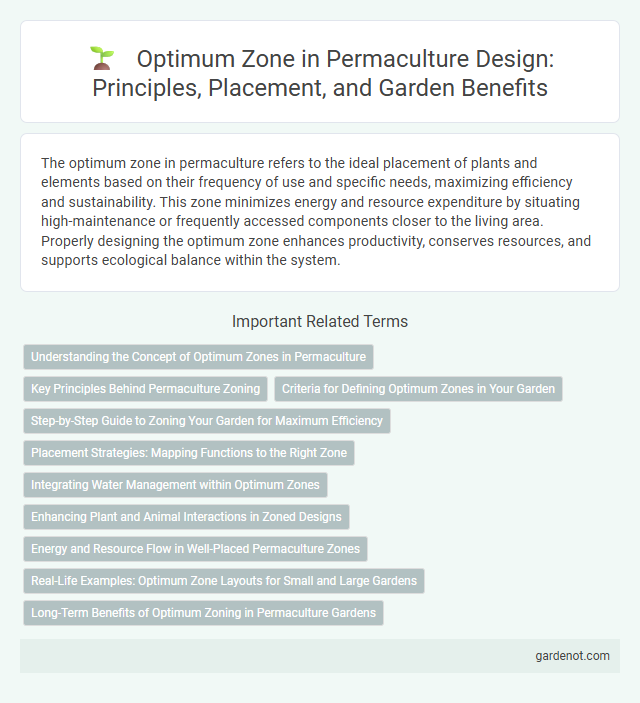The optimum zone in permaculture refers to the ideal placement of plants and elements based on their frequency of use and specific needs, maximizing efficiency and sustainability. This zone minimizes energy and resource expenditure by situating high-maintenance or frequently accessed components closer to the living area. Properly designing the optimum zone enhances productivity, conserves resources, and supports ecological balance within the system.
Understanding the Concept of Optimum Zones in Permaculture
Optimum zones in permaculture refer to strategically designed areas within a landscape where resources, plants, and activities are placed for maximum efficiency and sustainability. These zones range from Zone 0, the home or central point, to Zone 5, the wilderness, based on frequency of human use and natural interaction. Understanding optimum zones allows for minimized energy expenditure, enhanced yields, and improved ecological balance in permaculture design.
Key Principles Behind Permaculture Zoning
Permaculture zoning optimizes land use by arranging elements according to their frequency of use and maintenance needs, promoting sustainability and efficiency. Key principles include placing high-maintenance plants and features in Zone 1 for easy access, while less frequently tended areas like orchards or wilderness occupy outer zones. This spatial design minimizes energy expenditure, supports biodiversity, and enhances ecosystem services within the permaculture system.
Criteria for Defining Optimum Zones in Your Garden
Optimum zones in permaculture are defined based on factors such as sunlight exposure, soil fertility, water availability, and microclimate conditions. Prioritizing accessibility, plant interaction, and maintenance requirements ensures maximum efficiency and productivity in your garden. Mapping these criteria helps create sustainable zones that optimize resource use and support healthy ecosystem function.
Step-by-Step Guide to Zoning Your Garden for Maximum Efficiency
Optimum garden zoning maximizes efficiency by strategically arranging plants based on their growth needs and maintenance frequency. Begin by placing high-maintenance herbs and vegetables in Zone 1, closest to your home for daily access, while perennial plants and less-frequented crops belong in Zones 3 to 5. This step-by-step zoning approach conserves time, resources, and energy, fostering a sustainable permaculture system.
Placement Strategies: Mapping Functions to the Right Zone
Placing elements in optimum zones maximizes efficiency by aligning functions with their natural frequency of use and maintenance needs, reducing energy and labor inputs. Mapping functions to the right zone in permaculture involves analyzing site-specific factors such as sunlight, water flow, and accessibility to ensure that high-maintenance plants and resources are close to living spaces. Effective zone placement enhances productivity, conservation, and sustainability by supporting natural patterns and minimizing environmental impact.
Integrating Water Management within Optimum Zones
Integrating water management within optimum zones in permaculture ensures efficient use of natural rainfall and runoff by leveraging contour swales, rain gardens, and keyline designs that maximize infiltration and minimize erosion. These strategies capture, store, and slowly release water, creating resilient microclimates and enhancing soil fertility in targeted planting areas. Effective water management within these zones promotes healthy plant growth while reducing reliance on external irrigation sources.
Enhancing Plant and Animal Interactions in Zoned Designs
Enhancing plant and animal interactions within permaculture's optimum zone involves strategically placing companion species to improve pollination, pest control, and nutrient cycling. Zoned designs prioritize proximity of symbiotic plants and beneficial insects or animals, maximizing ecosystem productivity and resilience. This deliberate integration fosters a balanced microhabitat that supports sustainable food production and biodiversity.
Energy and Resource Flow in Well-Placed Permaculture Zones
Optimum zones in permaculture prioritize efficient energy and resource flow by strategically placing elements close to zones of highest activity and use. This arrangement minimizes labor, reduces waste, and enhances sustainability through streamlined water, nutrient, and material cycles. Effective zone planning leverages natural patterns to maintain ecological balance and maximize productivity.
Real-Life Examples: Optimum Zone Layouts for Small and Large Gardens
Optimum zone layouts in permaculture strategically position plants and resources based on their frequency of use and maintenance needs, enhancing efficiency and sustainability. In small gardens, herbs and salad greens are placed in Zone 1 nearest to the house for daily harvest, while larger fruit trees and perennial plants reside in outer zones for less frequent attention. Large gardens integrate animal husbandry and water management systems in outer zones, maximizing land use and reducing labor through thoughtful spatial design.
Long-Term Benefits of Optimum Zoning in Permaculture Gardens
Optimum zoning in permaculture gardens strategically places plants and resources to enhance energy efficiency and maximize productivity over time. By concentrating maintenance-intensive elements close to living areas and allocating less demanding zones farther away, gardeners reduce labor and resource inputs while improving ecosystem resilience. This zoning approach promotes sustainable yields, soil health, and biodiversity, ensuring long-term ecological and economic benefits.
Optimum zone Infographic

 gardenot.com
gardenot.com